|
"...the right
of people to bear Arms, shall not be infringed." |
| |
The
information presented on this web-site has been
assembled from different sources deemed
reliable, and represent personal views of the
author on specific issues associated with
handguns ownership, lawful use and concealed
carry. Those views shall not constitute an
advice of any kind to purchase a handgun or
ammunition described below. The author shall not
be liable in any way for any wrongful use, or
misinterpretation of the presented information.
|
|
|
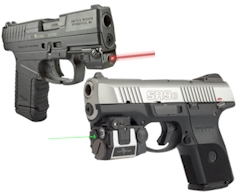 |
|
|
|
 Visits since 07/2011
Visits since 07/2011 |
|
|
NEW TEXAS GUN LAWS INFORMATION (2021 UPDATE)
|
| CHL
BASICS
...top |
Buying or carrying a gun may create a false sense of security.
Unless you know and follow the law, develop handgun handling
proficiency, including its safe-keeping, maintenance and use.
Otherwise, it
may get you into trouble instead of providing security.
Having CHL (Concealed Handgun License) don't make you a policeman. Understand well, what "imminent
threat" means, and when the use of deadly force is "justifiable".
Develop "adult-to-adult" conversation skills. Your handgun is to "stop",
not to "kill". Anticipate the situation and be prepared to
handle it. Practice your defense skills, develop your character,
develop "muscle memory" of handling your handgun. Never put
finger on the trigger unless ready to fire. Never point a handgun at
anybody, even if it's not loaded. Keep the handgun out of reach by
anybody other than yourself.
Review
handgun laws
(Texas)
regularly.They do change (please check the above updates). They vary from State to State.
When traveling, know which States have reciprocity, and how
different the law is. If you wish to
stay informed, and support the gun owners' rights, consider becoming
a member of National Rifle Association.
In Texas and most other States, failure to conceal a handgun by
CHL holder is considered "criminal offense", or at least
it must be holstered. There are many ways to conceal a handgun,
which is a matter of personal preference. Plenty of options are
available for various applications (pocket, shoulder, ankle, thigh,
paddle, belt, shoulder or belt pouch, belly band, in waist, etc...).
OWB leather holster seem to be more practical and convenient for
most despite its price.
OPEN CARRY IS NOW ALLOWED IN TEXAS, BUT HOW WOULD YOU
EXERCISE THIS RIGHT?
Open carry may deter
some criminal activity, but not every criminal will be scared of
your gun. How would you know who you are up against? Criminals are
able to read body language very well and would know who is prepared
to use the gun and who isn't. Most had guns pointed at them their
entire lives and many have already been shot multiple times. Those
criminals won't be scared just because that gun on your hip.
Instead, they may shoot you or kill you to get your gun before
committing a crime. Some of them would see your gun as a challenge,
but not a threat. It may boil down to whether you can draw your gun
quicker. According to some sources, every year dozens of cops, even
those who are trained well, have a backup and retention holsters,
get their guns taken by criminals. Would they be able to take
your gun out of your open carry holster? How would
the element of attraction compare to the
element of surprise? When you open-carry an "attraction" --
your handgun -- a criminal may catch you by surprise, but if your
handgun is concealed, you have a better chance to catch that
criminal by surprise.
What would a policeman think of you when he sees you openly
carrying a handgun? How would the policeman react, especially in the
dark? What if you make a wrong move and it is interpreted by the
policeman as a threat? Imagine what would happen then!
Open-carry of a handgun will draw attention and can be viewed as
a warning or threat to ordinary people, law enforcement and
criminals alike. If you decide to open-carry your handgun, first
think of the purpose, the objective and possible consequences. If
your concealed weapon is good enough for the purpose of
self-defence, why would you expose it?
If you don't carry a handgun and see someone with a handgun on
his belt, how would you react? If you are carrying a concealed
handgun, how would you react? If you are open-carrying a handgun,
how would you react?
 
When you not at the shooting range, use your time wisely
-- consider reading books that drive the imagination.
|
|
EXPECTATIONS
...top |
Who wouldn't want
to own a handgun, which is:
> Simple (Intuitive)
> Easy to use/handle
> Light weight (Modern polymer material)
> Compact (Concealable)
> Effective (Caliber and ammunition)
> Accurate (Barrel length, sights)
> Reliable (Manufacturer, design)
> Looks good
> Feels good
> Reasonably priced |
How would you choose from a
huge number of designs available in the market place?
You may wish to start with the country you would want your
handgun to be made in, check the reputation of the handgun
designer/manufacturer, and choose the caliber.
Decision making is tough, and whether it's right or wrong,
it would be your decision anyway.
Define your purpose, and how you're going to carry and
conceal the handgun. Would it be a good fit for your hand? |
|
SELECTION
...top |
Which one would be a "preferred candidate", a revolver, or a
pistol (semi-auto)? Would it be single action, or double action? It
would be good to know the difference, wouldn't it?
Once a handgun is bought, it's a "point of no return". There would
be fewer options left: keep, re-sell, trade in, put it away, or
destroy it. Knowing
what you need and what you are buying should mean a lot. |
Here are 2 examples of diametrically opposite opinions about the
same gun, found on the Internet chats:
Guy 1: "This was a big mistake of mine to buy this gun. Right out of
box it jammed on me a few times and I had to send it back to the
manufacturer. I would never recommend this gun to my friend".
Guy 2: "I am a retired police officer, and throughout my career I
carried many different guns, which I still have, but when I bought this one, I
liked it so much, and it's the only handgun I carry now. I would
definitely recommend it to my friend".Whose opinion would you
follow? Is there anything wrong with the statements they made? Yes.
Guy 1 could have used a bad (cheap) ammunition. Guy 2 didn't mention
which guns he carried.
So, there is no telling which opinion would be good to apply.
It's good to have your own. You may wish to visit the web-sites of
manufacturers and read more about the handgun you consider
purchasing, then shop for it.
Once handgun is bought, keep its mechanism clean and oiled. Only use
fine quality reliable
ammunition and the chances of your handgun failing you in a critical situation
would be reduced.
How would you go about selecting a
handgun? 1. Identify its primary purpose -- Concealed
carry -- Home defense -- Range Practice -- Competition -- Hunting
2. Decide on the size -- Full Size -- Compact -- Subcompact (*)
3. Decide on the type of gun -- Revolver (Hammer or hammerless) --
Striker-firing or Hammer-firing Pistol (with or without manual
safety)
4. Decide on action -- Single Action -- Double Action
(mind trigger pull force/weight, its travel to "wall" and audible
reset)
5. (*) Decide on barrel length (longer barrels result in
higher velocity and improve acccuracy)
6. Decide on magazine capacity (mind different
State by State regulation!)
7. Decide on the caliber -- 9mm (most
common) -- 380 ACP (most concealable, yet sufficient) -- 357 Magnum
-- 38 Special -- .40 -- .45 -- other calibers
8. Choose a
reputable brand (mind pricing)
You should not buy a gun
online and victimize yourself by its advertized popularity or
performance. First go to a gun store and check the gun you intend to
buy. You should be able to answer these questions:
- Does it feel
good holding it in your hand and aiming?
- Can you reach the
trigger with your index finger and pull it comfortably (critical for
double action firing)?
- How easy is it to pull the trigger
whether its double action or single action? Measure trigger weight,
if you can. It does vary from brand to brand and from gun to gun.
Ideally, trigger pull should be ~3-5 lbs (single action) and ~8-10
lbs (double action).
- Can you easily manipulate the slide?
-
Is it easy to manipulate the magazine release button and the slide
release lever?
- Do you feel comfortable aiming with the use of
factory installed gun sights?
- Is the rear sight adjustible for
windage (!) and elevation? Proper windage tune-up is critical -- at
5 or 7 yards you may still hit the target, but may miss it
completely at 10 - 15 yards. Whether your vision is near-sighted or
long-sighted, the sights may still apear blurred. Astigmatism makes
it even more challenging to properly aim at target. You should be
prepared to adjust your gun sights to impove accuracy (suggested
steps are down below in Aiming & Shooting section).
Check this website for deals before buying elsewhere:
www.gunzonedeals.com and
check the price in cart. It may surprise you! How would you select a
holster? Selecting the right holster is critical. It
should allow you to concealed carry comfortably and draw easily.
Compare these OWB designs:
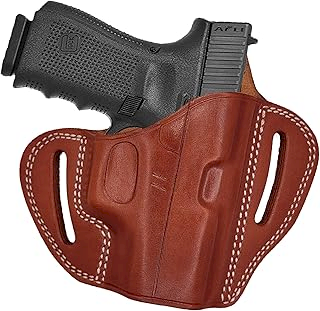 |
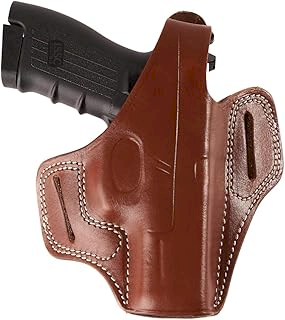 |
| NOT AN
EASY GRAB & DRAW! |
EASY GRAB & DRAW! |
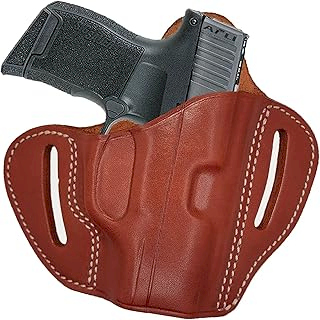 |
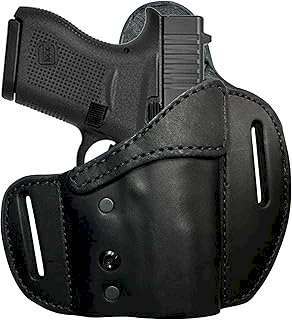 |
| NOT AN
EASY GRAB & DRAW! |
EASY GRAB & DRAW! |
|
|
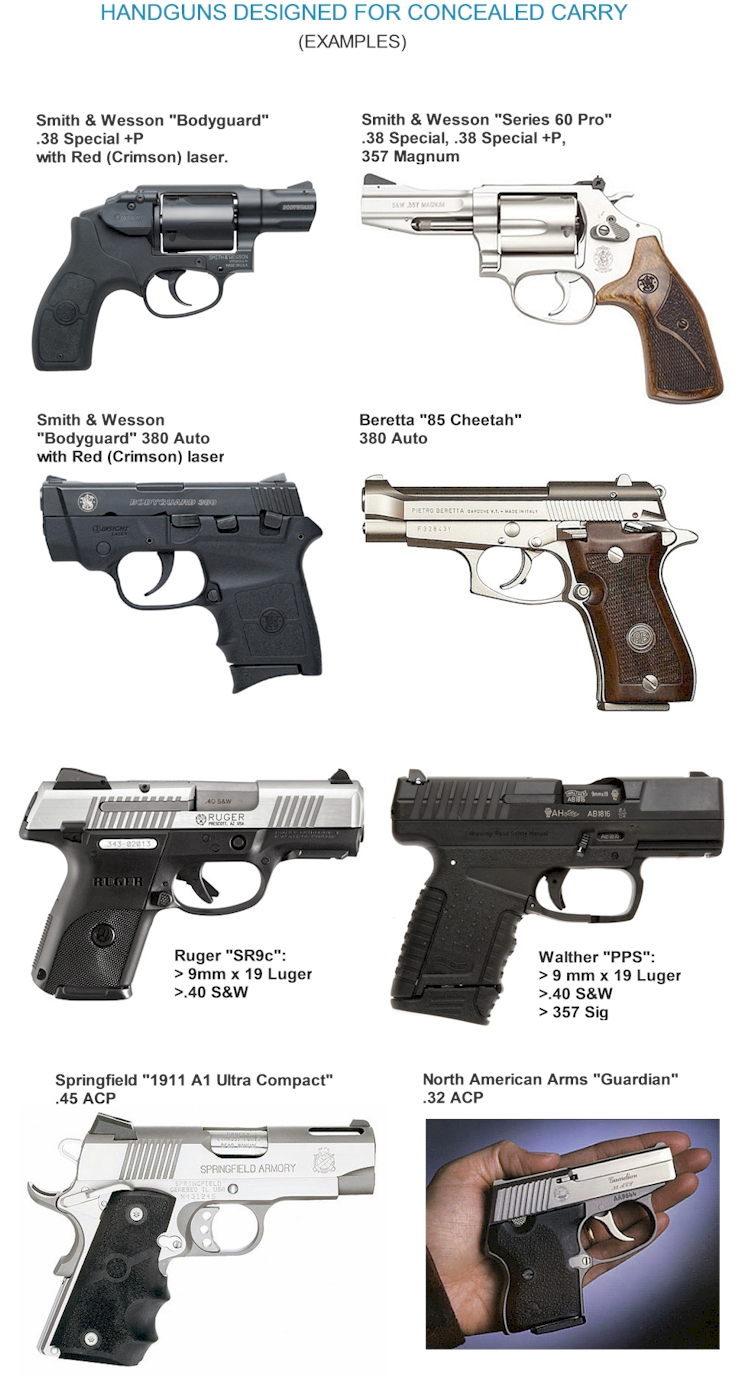
Some handguns come with Tritium night
sights, and/or lasers, or designed to be equipped with them.
In addition, there are laser/flash light combos, and 140 - 220 lumen
flash lights, some with strobe,
to blind/confuse the attacker, when acting in the dark.
Interesting concept of a "pocket shotgun" by
Bond
Arms Inc.
Single action only firearm with
16 interchangeable barrels and 22 calibers combinations,
including:
45 Colt/.410 Shot Shell (rifled), .357
Magnum /.38 Special, .357 MAX,
.45 ACP,.45 Colt only, .45 Glock Auto,
.44 Special, 44-40 Winchester, .40 S&W, 10 mm, 9 mm
Luger, 32 H & R Mag, .22 Long Rifle |

Texas Pride |
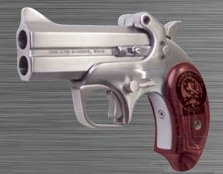 |
Here is a 357 Magnum "Rhino" by Chiappa Firearms, Ltd.,
shown are 2" and 4" barrels
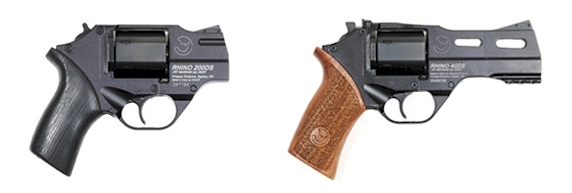
That one should take care of a rhino, or a hog, or a grizzly
bear, anything with thick skin and a big mass.
Note, that cal. 357 Magnum load is what makes the difference.
Rhino is
just a different gun design...
Another "Pocket cal. 9 mm Pistol", short 3.2" barrel, with 7
round magazine by Ruger
| LC9 and LC9s
Light weight semi-auto, double action only, pistol
featuring manual and magazine safety.
Low recoil for quicker target recovery.
Adjustable front and rear sights.
The grip feels right, nice and slim with smooth edges.
Ladies may like it a lot.
Those who may think LC9 is too big for
a pocket gun, have a look at Ruger LCP .380, also
available with optional crimson laser.
LC9s is equipped with additional trigger safety. |
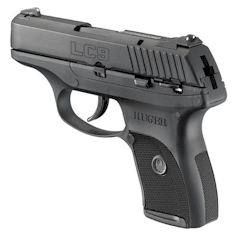
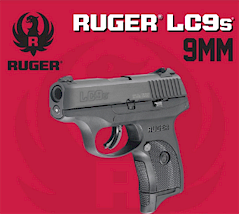 |
More 9 mm concealed carry and "pocket" handguns by Bobers Arms,
Smith&Wesson, Sig Sauer, Diamondback, Glock...
| Bobers
Arms XR9-S
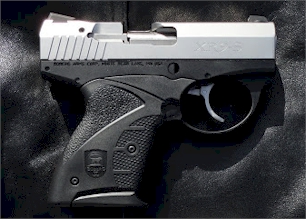
Interesting design where the round is pulled backwards
before chambering. |
Sig Sauer P938 Equinox
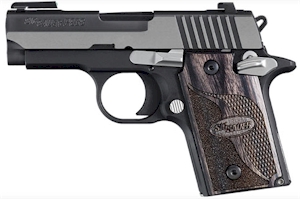
Miniature classic 1911 pistol. Available in .380 ACP
(P238) and 9mm (P938). |
Smith & Wesson M&P Performance
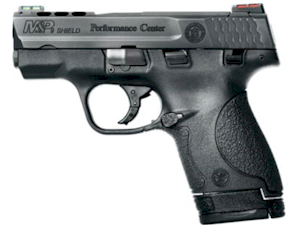
Also available: 40S&W and 45 calibers |
Sig Sauer P365
Nitron Micro Compact
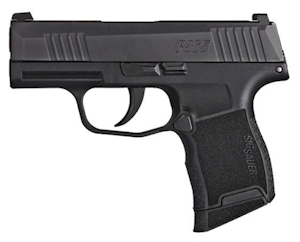
Available in 9 mm |
Glock "micro" (Made in the U.S.A.)
Glock 42 (.380 ACP), 43, 43X (9mm), 48 (9mm, 43X
with a longer barrel).
Available in a variety of frame
colors! Ladies may like the look and feel of G42!
Shown:
- Custom trigger
(flat)
- Custom front sight
(fiber optic)
- Magazine extension
- Stainless steel
recoil spring
- 3.5 lb connector
- Milled extended lock plate |
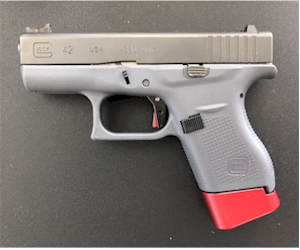 |
Smith & Wesson 9mm CSX e-series
(comes with 3 mags of various
capacities)
Accurate, manageable recoil, smooth function
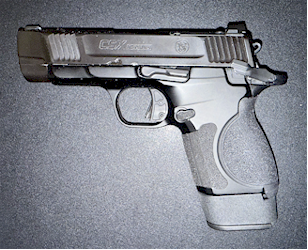
Click for
More details
|
Diamondback SDR 357 magnum or 38 Special +P
Six rounds capacity, DASA,
attractive design, fiber optic sights, manageable
recoil, smooth function
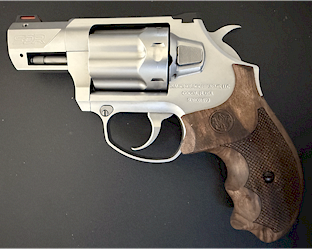
Click for
More details |
|
|
|
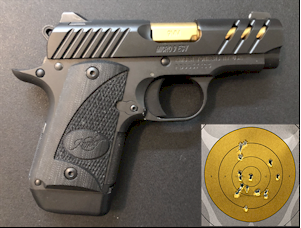
Boyert Shooting Center at
7 yards (04/25/21) |
Kimber Micro 9 ESV (Made in the U.S.A.)
Caliber 9mm, similar to SIG SAUER P938 (a miniature
911). Most P938 holsters can be used for its concealed
carry.
Specific for this particular model:
- Stainless steel barrel with
TiN coating
- Ported slide
- Tritium night sights
- Aluminum frame
- 6 or 7
rounds magazine capacity (Sig's P938 6-rd magazine is
compatible, 7-rd is not but can be worked over to fit).
You may consider replacing Kimber's mag release with
P938 Gen 2 mag release;
Aftermarket spring set
is available
HERE to reduce the trigger pull force(weight) from ~7 lbs
to ~5 lbs
|
|
|
|
WALTHER PERFORMANCE DUTY PISTOL COMPACT (Walther
PDP)
Equipped with PDT (Performance Duty
Trigger) -- light weight (3.5 lbs), short travel, distinct wall,
crisp reset.
Sights are compatible with Glock, adjustable rear
sight (both windage and elevation).
Four-inch barrel,
fifteen-round capacity. Red Dot ready. Excellent ergonomics!
Made in Germany
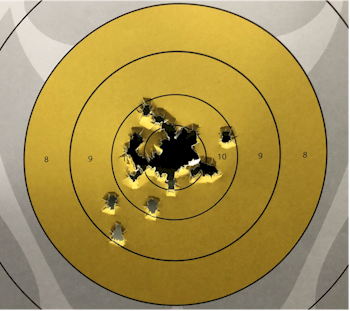 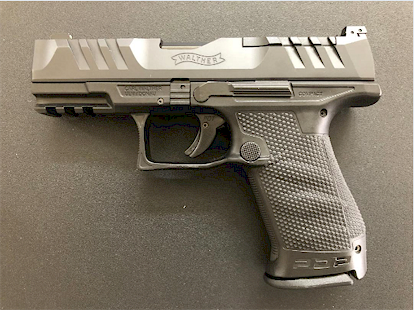
Boyert Shooting Center in Katy (June 2021)
8" target at 10 yards, box of 50 9mm
rounds |
Fifty rounds at 7 yards (8"
target):
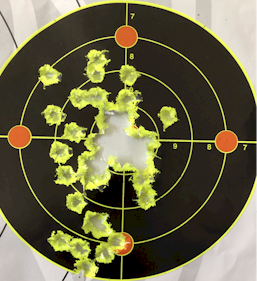
Boyert Shooting Center in Katy (July 2019) |
ARCHON FIREARMS
9mm TYPE B
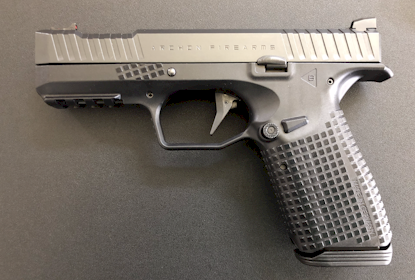
Concept - Russia;
Engineering - Italy; Manufacturing - Germany/USA;
|
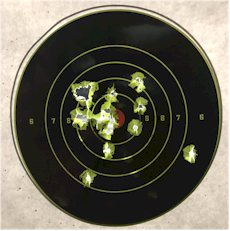
Boyert Shooting Center in Katy
(Feb 2021)
8" target at 7 yards, two 10 rd magazines |
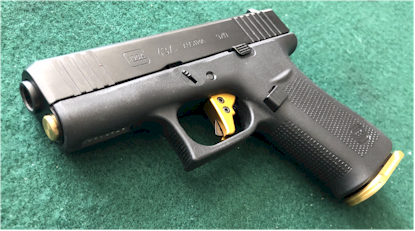
Glock 43X with upgrades
(SS Recoil Spring, Flat Trigger,
Connector, Magazine Floor Plate) |
| |
|
| |
|
To learn more about the above handguns,
please visit the manufacturers' web-sites |
|
|
"STOPPING POWER" AND AMMUNITION
...top
|
"Guns don't kill people. People kill people." You heard that
before, right? Let's re-phrase it by saying: " Guns or people don't
kill people -- bullets do!"
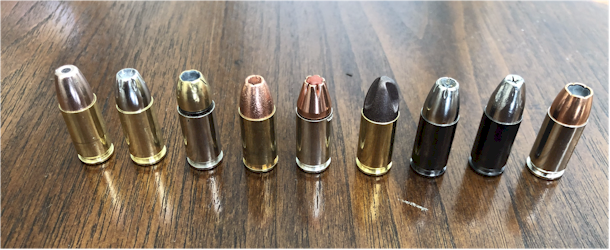 What to look for when
selecting ammunition (any caliber)?
What to look for when
selecting ammunition (any caliber)?-
Penetration (recommended 12-16 inches, mind bystanders
due to overpenetration or ricochet)
It is a function of velocity and
bullet type - FMJ vs. HP.
-
Expansion (applied mostly to HP configurations,
increases wound cavity causing terminal bleeding)
It is caliber-sensitive and subject to
clogging by clothing.
- Reliability (consistent performance)
It is important to avoid ammo that
frequently fail to ignite (defective primer or low powder load)
- Bullet weight retention (effects
the outcome of penetration and/or expansion)
It is important to avoid ammunition
when separation of jacket from the core occurs (both FMJ and
JHP).
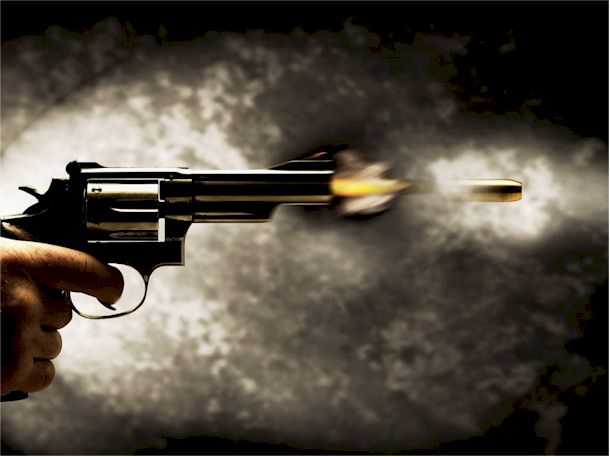 |
In addition to popular full metal jacket or hollow
point bullets, some new designs are offered for some very specific
applications, for example, self/home defense, hunting, or official
duty-related use, not to mention various military applications. When
choosing a caliber and comparing the ballistics of different
ammunition and brands, a smart decision ought to be made whether the
subject bullets correspond with the anticipated outcome of shooting
in certain situations. It makes sense to have multiple magazines
loaded with different ammo depending on anticipated application. In
crowded areas and at home you may consider using low velocity rounds
with hollow point bullets, out in the open - higher velocity rounds,
while driving - ammo with the ability to break through barriers and
finally excersice seasonal approach (dealng with winter vs. summer
clothing).
Keep in mind, that for many years the FBI most
used caliber was .38 Special (snub-nose revolvers), while 9mm Luger
(and .45 1911) was and still used primarily by military personel.
The 380 Auto ammunition is also 9mm but with shorter casing (less
powder) and may be lethal as well when used for self-defense (short
distance).
Stopping power is always referred to when calibers are discussed.
The perception is that the larger caliber has more stopping power.
There is some truth to it, but...
There should be a measure, by which the Stopping Power is measured
-- a
certain number.
Would Energy be a better word to describe Stopping Power? When a
projectile hits human body and stops there, then all energy is
transferred. If a projectile passes through, the energy is
transferred partially. Let's see...
E = (Q x V squared)/ 2G, where:
E is energy
Q represents the weight of projectile (Variable)
V is velocity (Variable)
G is gravity (Constant)
It is obvious that the higher the
weight of projectile, or it's velocity, or both, the higher the energy.
Shock/damage is one thing, but bleeding is known to be the cause of
death. So, penetration through skin with further hollow point bullet
expansion/fragmentation are the two most important components
contributing to effective fire power applications.
Now, let's look at 2 scenarios. You are hunting, and would like
to make sure you have a gun that would stop a bear, or a big wild hog.
Ideally, you would be wanting to transfer ALL energy, rather
than "pierce" the animal and only transfer a portion of the energy.
If that's the case, would 357 Magnum load with a heavy projectile be
a good solution? Probably. It is known to be a good solution - sufficient
velocity along with heavier projectile, optimized for energy transfer.
According to the information presented below, .45 Auto with 185
grain projectile would deliver 453 ft lbs energy at a 1050 fps
velocity, similar to 357 Magnum ammunition designed for hunting. The
ammunition, believed to be the most effective (damaging), i.e. 357
Sig, is rarely used/available and expensive, thus is left out of the
discussion. By no means should .357 Sig be out-ruled though. Handguns with barrels designed for .40 S&W can be
converted into 357 Sig by switching the barrel accordingly.
With the same caliber load, projectile with lower weight would
travel at a higher velocity, and will have a higher piercing
effect. Higher velocity would also mean a better penetration, but on
a flip side - a higher chance of over-penetration and ricochet. Self-defense handgun
ammunition is designed for an animal with thin skin and a tissue
containing 80% of water, i.e. us, humans. It appears that hollow
point projectile causes most shock/energy transfer, when it hits the
target it's designed for. Otherwise, in cases of higher velocity
loads, over-penetration and ricochet may present a serious problem.
Using hollow point ammunitions that provides for
about 350 - 500 ft lbs of energy at velocities of 1000 fps to 1200
fps, would probably be most appropriate for self-defense
applications. Higher energy rounds might create a
kick back (hardly managable recoil) making it harder to recover the target
quickly enough due to muzzle
jump.
From the table below certain .38
Special, 9 mm, .40 S&W and .45 Auto would be sufficient, although
using smaller, or less powerful ammunition, can be equally effective
in certain situations. With 357 Magnum ammunition, that delivers
higher velocities, the energy it creates is high, but so is the
piercing effect, and it is hard to say how much of that energy is
transferred to the target, and how much continues to push the
projectile farther. With possible innocent by-standers in mind,
would you load your revolver with 357 Magnum ammunition to be used
within city limits? Probably not, as it would be beneficial to avoid collateral damage
by all means.
One other important matter to mention is the length of the
barrel. Longer barrels have better accuracy and deliver higher
velocities. The ballistics presented below is measured for 4" barrel
guns. In the concealed carry world, 2.0", 2.5", 3.0"and 3.5" barrels
are often used. So, expect the energy and velocity to be slightly less than such in
the table, if you use handguns with shorter than 4" barrels.
|
| |
Left to right:
.32 Auto
380 Auto
9 mm x 19
.40 S&W
.45 Auto
38 Special +P
357 Magnum
.40 S&W Solid Copper |
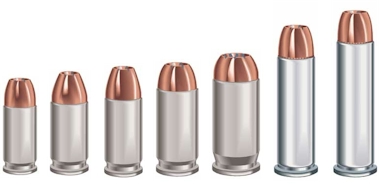 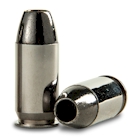 |
|
BALLISTICS BY CALIBER
(The select ammunition referenced below)
...top |
Energy
ft lbs |
.32 Auto |
380 Auto |
.38
Special |
9 mm
LUGER |
9 mm +P |
.40 S&W |
.45 Auto |
357 Magnum |
Velocity
fps |
|
123 |
60 (S) |
|
|
|
|
|
|
|
960 |
|
215 |
|
|
110 (F) |
|
|
|
|
|
930 |
|
216 |
|
90 (F) |
|
|
|
|
|
|
1040 |
|
249 |
|
|
110 (H) |
|
|
|
|
|
1010 |
|
290
+P |
|
|
110 (H) |
|
|
|
|
|
1090 |
|
326 |
|
|
|
147 (BR) |
|
|
|
|
1000 |
|
339 FTX |
|
|
|
115 (H) |
|
|
|
|
1140 |
|
345
SC |
|
|
|
|
|
140 (B) |
|
|
1120 |
|
345 |
|
|
125 (UW) |
105 (F) |
|
|
|
|
1230 |
|
364 |
|
|
|
124 (S) |
|
|
|
|
1150 |
|
364
SC |
|
|
|
93 (M) |
|
|
|
|
1330 |
|
387 |
|
|
115 (ES) |
|
|
|
|
|
1185 |
|
393 |
|
|
|
65 (IN) |
|
|
|
|
1650 |
|
396 FTX |
|
|
|
|
|
175 (H) |
|
|
1045 |
|
410 |
|
|
|
|
124 (S) |
|
|
|
1220 |
|
413 |
|
|
|
108 (NO) |
|
|
|
|
1312 |
|
443 |
|
|
|
124 (SS) |
|
|
|
|
1165 |
|
453 |
|
|
|
|
|
|
185 (S) |
|
1050 |
|
480 |
|
|
|
|
|
150 (CB) |
|
|
1200 |
|
496 |
|
|
|
|
|
155 (S) |
|
|
1200 |
|
506
FTX |
|
|
|
|
|
165 (H) |
|
|
1175 |
|
510 |
|
|
|
|
|
|
|
180 (F) |
1130 |
|
532
SC |
|
|
|
|
|
60 (L) |
|
|
2000 |
|
548 |
|
|
|
|
|
|
|
158 (H) |
1250 |
|
584 |
|
|
|
|
|
|
|
125 (S) |
1450 |
|
624 |
|
|
|
|
|
|
|
125 (H) |
1500 |
|
|
Bullet weight (Grain) |
|
|
|
The ammunition manufacturers may
discontinue certain items shown below and offer different new items,
especially pertaining to the bullet designs and their intended
applications.
It is a very competitive and dynamic market to track.
New bullet designs evolve from time to time and one can always make his/her own list of favorite rounds based on
their availability.
| Speer Gold Dot
(S) |
|
Extreme Shock
(ES) |
|
| .32 Auto |
23604 |
.38 Special
"EPR" |
38SPL115EPR20 |
| 9 mm Luger |
23618 |
Cor-bon (CB) |
|
| 9 mm Luger +P |
23617 |
.40 S&W |
SD40150/20 |
| 357 Magnum |
23920 |
|
|
| .40 S&W |
23961 |
"Clean" Target
Practice Ammunition |
|
| .45 Auto |
23964 |
Remington (R) |
|
| Federal Premium
(F) |
|
380 Auto UMC Target |
LN380AP |
| 380 Auto/Low Recoil |
PD380HS1H |
9 mm UMC Target |
LN9MM3 |
| .38 Special/Low Recoil |
PD38HS3 |
.38 Special UMC Target |
LN38S11 |
| 357 Magnum Swift-A-Frame |
P357SA |
.40 S&W UMC Target |
LN40SW4 |
| 9 mm Luger "Guard
Dog" |
PD9GRD |
|
|
| 9 mm Luger PUNCH |
|
|
|
| Hornady (H) |
|
Magtech (M) |
Light weight to
carry |
| 38 Special "Critical Defense" |
90310 |
9 mm "First Defense"
Solid Copper |
FD9A |
| 38 Special + P "Critical Defense" |
90311 |
|
|
| .40 S&W FTX®
"Critical Defense" |
91340 |
Liberty (L) |
|
| .40 S&W FlexLock™
"Critical Duty" |
91376 |
40 S&W Solid Copper |
USM40 |
| 357 Magnum "Critical Defense" |
90500 - 90562 |
9 mm +P
Solid Copper HP |
|
| 9 mm Luger FTX® "Critical Defense" |
90250 |
SIG SAUER (SS) |
Elite performance |
| Barnes (B) |
|
V-Crown
JHP |
E9MMA2 |
.40 S&W "Tac-XPD"
Solid Copper
YouTube Demo |
BPD40SW1 |
Browning
(BR)
9 mm
BXP (X-point JHP) |
Penetrate & Expand
B191700091 |
| Norma (NO)
Monolithic Hollow
Point |
|
Inceptor
(IN) |
|
| 9 mm Luger 108 gr MHP |
|
9 mm Luger 65 gr ARX |
|
|
Underwood (UW) |
|
Winchester |
|
| .38 Special +P
XTP JHP |
|
9 mm Ready |
Penetrate & Expand |
| |
|
9 mm Silvertip |
Optimal
Expansion |
|
|
"Critical
Defense" bullets are said to have been designed to expand
quickly upon entering a human body, thus transferring most of its
energy, and least likely to ricochet or have an excessive
"piercing" effect that might cause collateral damage. The key word
is "defense".
Contrary to that concept, "Critical
Duty" bullets - "high-antimony lead"
barrier ammunition - are designed to penetrate
through heavy clothing, sheet metal, glass, wallboard, plywood,
etc., and continue on its pass to hit a human target. The key word
is "duty".
More information about the Hornady's bullet concepts could be found
on the company web-site.
EPR =
Enhanced Penetration Round.
EXTREME SHOCK
rounds are designed to transfer 100% of their energy to the target
through controlled fragmentation, which causes massive shock trauma,
instantly shutting down the Central Nervous System. Its frangible
and reduced ricochet properties provide for a greater level of
safety in urban and home defense applications. Some tests show that
due to fragmentation, only a small portion of the bullet reaches the
desired depth. So, claims about effective penetration may be over
exaggerated due to dissipation of the energy resulted from
fragmentation, whether pellets or metal powder is jacketed in the
bullets.
Relatively new trend in
ammunition
There are a few reasons for the recent ammunition
developments. One reason is that the environmentalists insist on
prohibition of lead core bullets and are succeeding in various
States. Another reason is to reduce the weight of the ammunition
used by the military and for concealed carry. Frangible bullets and
copper-polymer type ammunition is now being offered too. More and more manufacturers are moving towards
the lead-free ammunition. So, the ammunition with bullets made of
solid copper is seen in retail stores more often.
Obviously, the copper bullets are lighter than
the lead ones and travel at higher velocities compared to the lead
bullets. To compensate for the loss of bone crushing energy
due to the loss of weight, higher velocities are necessary. For
example, higher pressures (+P) are used in 9 mm and .45 Auto
ammunition. The .40 S&W caliber appears to produce sufficient
pressure.
The velocities of 2000 fps and the energy of about 500 ft
lbs have been achieved according to public information with 50-60
grain all solid copper bullets. The question
remains as to how the piercing effect can be reduced and most energy
transferred with certain calculated penetration, i.e. 12" - 16" in
standard gel test with 4 layers of denim in front.
It all narrows down
to the bullet design. Most solid copper bullets either fragment and
under-penetrate upon entry causing severe shock and residual
bleeding or flower-bloom to avoid over-penetration in excess
of 16". In real life the outcome
depends on the angle of entry, distance to the target, length of the
gun barrel and other factors. Evidently, bullets
that are designed to penetrate thicker
animal skin and then expand would be very different.
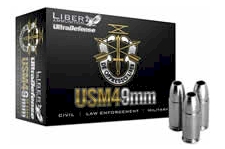 |
Liberty Ammunition has come
with USM4 rounds in 9 mm +P (50 grain) and
.40
S&W (60 grain) with the velocities of 2000 fps and the
energies of 444 ft lbs and 532 ft lbs respectively. The
bullet design is lead-free hollow
point and supposed to fragment on entry and
transfer most of the energy to a human body, causing an
immediate and extreme shock. May be appropriate for use by law
enforcement and in self-defense situations. |
According to Liberty Ammunition, more calibers for
pistols and center-fire rifles will be made available to gun
enthusiasts and hunters.
Barnes, known as a quality bullets manufacturer, is
now coming up with their own line of ammunition with impressive
ballistics.
NEW AMMO/BULLET DESIGNS - 2021
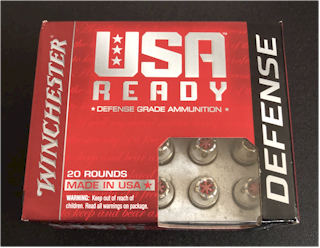 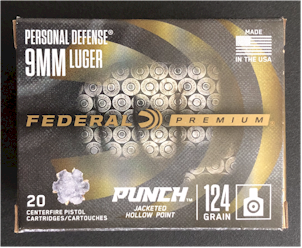
NEW
BURGLAR/LOOTER SHOOTER
NEW
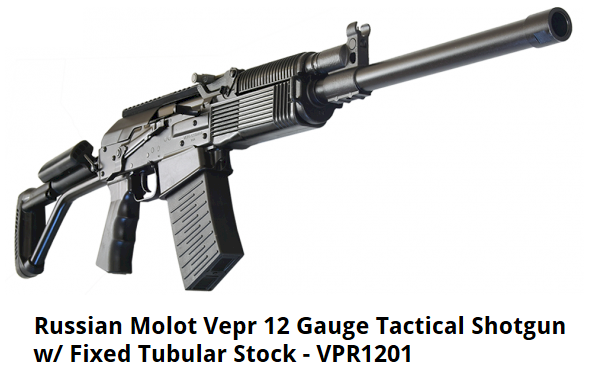
NEW
HOME DEFENSE SYSTEM
NEW
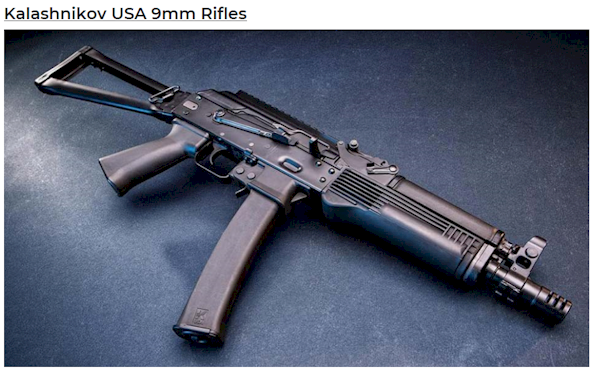
What shall we expect from Kalashnikov in 2021?
AKV-521
NEW
HUNT HOGS WITH CONFIDENCE
NEW
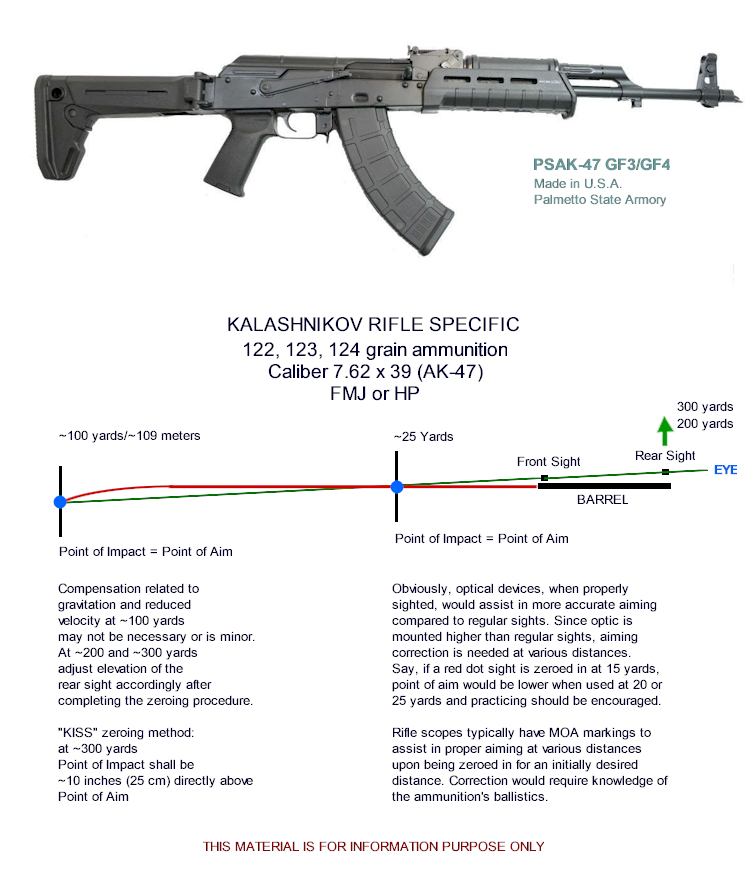
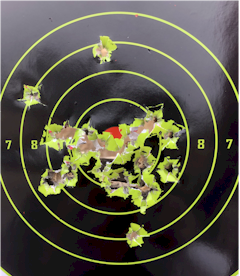 |
PSAK-47 GF3
Caliber:
7.62 x 39
(Monarch FMJ, 123 gr.)
Distance to 8" Target:
25 yards
Method of shooting:
Semi-automatic
Aiming:
Factory sights (no optics)
Capacity:
30-rd
magazine (all used) |
|
|
AIMING
AND SHOOTING (PISTOLS & REVOLVERS)
...top |
|
Currently, there is a big variety of handgun
sight designs, other than classic or fixed. Knowing exactly how to
aim your handgun is a must, not to mention the gun's ergonomics that
feels good in your hand with a convenient trigger reach distance.
Knowing how accurate your handgun, and your shooting, is a plus. So,
you may wish to target practice at different distances, say, 25, 20, 15, 10,
5 yards, and work on improvement of your target acquisition,
accuracy and develop so much needed "muscle memory". You
may consider below distances when making a defensive (justified)
decision in case of imminent threat to your own life. The time for
making such decision is limited by a few seconds!
- at 25 yards,
it is hard to make a clear judgement about potential threat;
- at 20 yards, it is time to become aware of a potential threat
(situational awareness);
- at 15 yards,
response may be necessary to
increase chances of survival to ~70%;
- at 10 yards, changes of
survival drop to <50%;
- at 5 yards, too late to respond with
slim chance to survive the assault;
Based on the above assumption, "critical" distance to make yourself
proficient (accurate) at shooting your firearm in self-defense would
be no less than 15 yards. If you do well at 15 yards, you would do
great at 10 & 5 yards for sure! While practicing at the shooting
range, one should attempt to achieve a tighter grouping and develop
so much needed muscle memory of handling your weapon (aiming and
pulling the trigger). In-bore laser
sightings could be used for precise zeroing in various gun sights
(factory, red dot, etc.) for certain select distances. Corellation
of aiming would be necessary for distances other than those used to
zero-in your gun/rifle. It may be tricky depending on the quality of
the laser. Expensive bore lasers are said to be more reliable. Unlike the laser beam, bullet trajectories
are
affected by gravity (subject to bullet's weight, type and velocity), not to mention
exposure to strong winds. For rather
long distances, sighting your rifle using in-bore laser would
probably be counter-productive.
|
Examples of sight designs

Examples of aiming |
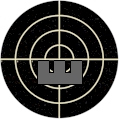 |
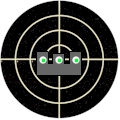 |
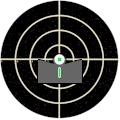 |
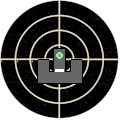 |
Traditional (standard)
(use under normal light condition,
whether sights glow or not) |
Three-Dot
glow sights
(align in the dark)
Tritium, Tritium with
Fiberoptic or phosphorous night sights (front
and rear) |
Big Dot Tritium Express sight (front and rear) |
Revolver with a night sight in front and adjustable rear sight
(elevation depends on distance to target and ammunition (38
Special, 38 Special+P or 357 Magnum) |
|
|
Depending on handgun design, red or green laser
could be installed to help improve "point and shoot" aiming
experience for shorter distances. Most recently red dot sights are
"pushed" on gun owners, forcing gun manufacturers to redesign slides
for mounting them. Nevertheless, practicing without
using any type of aiming aid might be
very beneficial to shooters. There are pros and cons of using lasers
or red dots for aiming. If zeroed in for certain distance from
target, correllation may be necessary to align "point of impact"
with "point of aim". This is not an easy task and practicing at
various distances should help nail it down.
Aiming your pistol with a laser or red dot
reveals your body pulse - the dot "jumps" arround the target and
bullets will follow such pattern. In my opinion, using "point and
shoot" technique with well-alighned sights is more practical to
achieve better accuracy.
How would you adjust
the sights (windage) for improved individual's accuracy?
1. Shoot 7-10 rounds at 7 yards.
- If
grouping is to the left, push front sight to the left or rear sight
to the right.
- If grouping is to the right, push front sight to
the right or rear sight to the left.
2. Shoot 7-10 rounds at 10
yards.
3. Make final adjustment, if necessary.
To avoid damaging gun finish, consider using
professional sight pusher or take the gun to a gunsmith.
Do you really
want to install a flashlight on your home defense weapon?
One should try to avoid revealing his/her whereabouts in the dark when
using lasers and/or high intensity tactical flashlights. Blinding of
intruder may work or may not -- it depends. Learning and practicing to surprise
intruders with those extra tools might not be a bad idea. The application would be different from a S.W.A.T. team assault mission,
say, the opposite of it. So, discussing the specific tactics of a defense mission with your gun instructor
would be advisable.
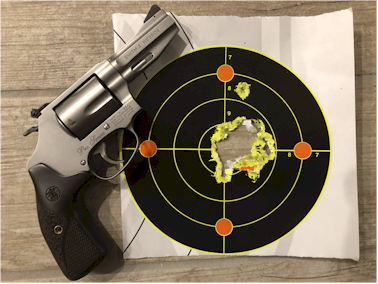 |
Series 60 Pro Smith & Wesson Revolver
357 Magnum (3" barrel)
@ Indoor Range (Boyert,
Katy, TX 77450)
Distance to 8" target:
10 yards
Ammo:
.38 Special FMJ/115 gr,
box of 50
Shooting
methods:
Single and double action
Sights:
Factory original |
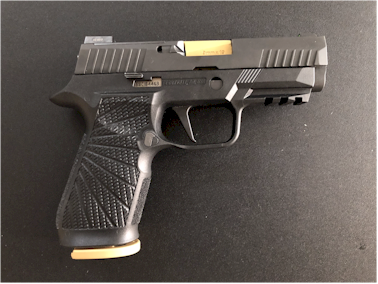
Sig Sauer P320 X-Carry - 9 mm (3.9" barrel)
with Wilson Combat Grip Module
|
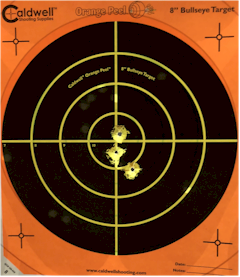
THE
FIRST THREE SHOTS @ 10 yards
Indoor Range (Boyert,
Katy, TX 77450) |
| |
|
|
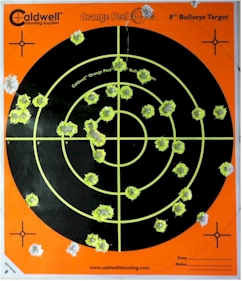 |
Sig Sauer P938 - 9 mm (3" barrel)
@ Indoor Range (Boyert,
Katy, TX 77450):
Distance to 8" target:
15 yards
Ammo:
9 mm FMJ/115 gr.
(PMC Bronze
)Shooting
method:
Single action
Sights:
Factory original
No aiming aid |
|
|
|
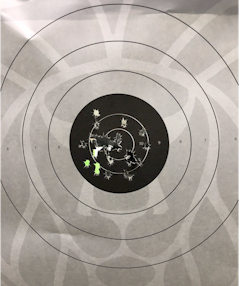 |
Sig Sauer P226 Legion - 9 mm (4.4" barrel)
@ Indoor Range (Boyert,
Katy, TX 77450):
Distance to target:
10 yards
Ammo:
9 mm FMJ/115 gr.
(Magtech)Shooting
method:
Single action
Sights:
Factory original
No aiming aid |
|
|
The simple method of achieving an
accurate shooting is to first align the sights, then point
the front sight at the target, hold your breath and gently
pull the trigger. Lower (reasonable) trigger pull force
would assist in more accurate shooting (*).
Aiming posture is believed to be a matter of
personal preference, while the straight posture (on the
left) is said to be mostly recommended by gun instructors during CHL
classes.
In this case deviation of windage (along horizontal
line, left or right) is reduced/controlled by a triangle
(body - left arm - right arm), not so much the elevation
(vertical line, up or down).
The alternative posture may provide for
a better control of both windage and elevation. In addition, it may reduce your own "target size" that is
aimed at by offenders.
It is important to select a gun that fits
your hand well. Different guns have different ergonomics and
triggers. If you do aim right, but miss the bull's eye after
a few shots, your handgun may not be designed for you.
Before buying your first, go to a shooting range, rent and
test-shoot the ones you consider buying.
(*)
The trigger is to be pulled gently to avoid
deviation along the horizontal line (windage). Using a "point and
shoot" technique should avoid deviation along the vertical
line, or both. Upon acquisition of target, hold your
breath before gently pulling the trigger, while maintaining
sights allignment on the target. If you master your own
shooting, potential winning of a gun fight by you would be
more likely.
...top |
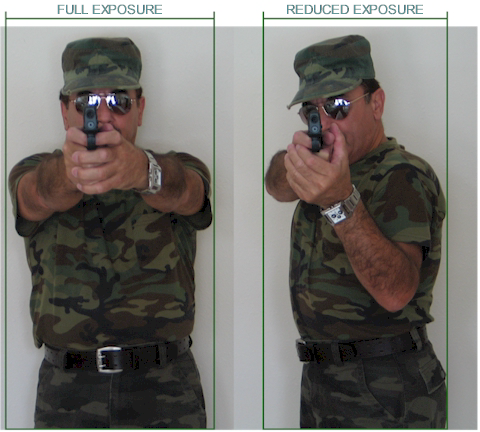
When target-shooting, those postures may help improve
accuracy, but in a real life situation, avoid exposure to
hostile fire by making yourself a larger target that is easy
to acquire. Think ahead before pulling your gun and
confronting armed offender.
Finally, follow the
concealed handgun law of the State in which you carry! |
|
|
|
|
NRA MEMBER
 |
|
Copyright
© 2011 Eutex Enterprises Inc.
Designed and engineered by
EUTEX ENTERPRISES
INC. |
|